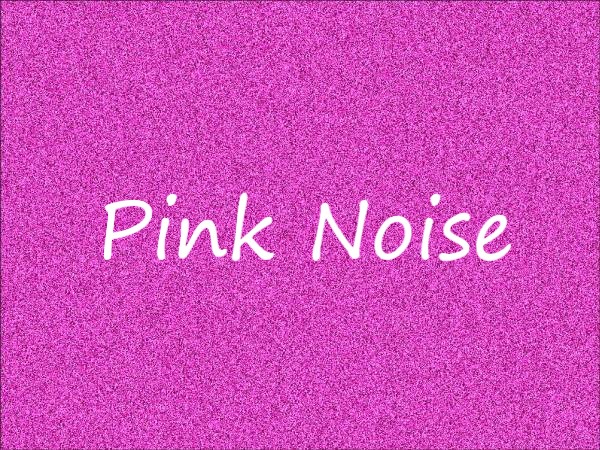ARTICLE – I recently read an article in Curiosity about how pink noise can help you fall asleep just like white noise. I knew about white noise being used for sleep but had never heard of pink noise (those of you steeped in the world of acoustics or engineering will have to forgive this biologist/entomologist for not knowing).
I also learned that in addition to helping you fall asleep, a couple of studies have indicated that pink noise can actually help your memory. That’s what got my attention since I have problems with sound sleep and memory.
First of all, what is pink noise? Well, according to Live Science, just like white noise, it contains
…all the frequencies that are audible to humans — 20 hertz to 20,000 hertz — but the way their signal power is distributed among those frequencies differs. White noise has equal power per hertz throughout all frequencies, while the power per hertz in pink noise decreases as the frequency increases.
As a result, the lower frequencies in pink noise are louder and have more power than the higher frequencies. However, most people perceive the sound of pink noise as being even, or flat, because it has equal power per octave.
(In acoustics, an octave is a frequency band whose highest frequency is twice its lowest frequency. For example, the band from 20 hertz to 40 hertz is an octave, as is the band from 40 to 80 hertz.)
And why do we call it “pink”? According to Dan Ellis from Columbia University, Department of Electrical Engineering (About Colored Noise, 2005),
… white noise sounds like the hiss of an untuned FM radio, or the background noise on a cassette tape player. Because of the particular characteristics of the human ear, the sound of white noise is dominated by the very highest frequencies. To make an audible noise that sounds more as if it is balanced across the full range of audible frequencies, we have to boost the low range (the ‘bass’ of a conventional stereo) and cut the high frequency; there is still energy at every frequency, but now the balance is shifted. If we were to do the same thing with visible light – which is an electromagnetic wave varying through the colors of the rainbow from red at the lowest frequencies through to blue at the highest frequencies – we would get a pinkish color. Hence this kind of noise is called pink noise. Pink noise sounds more like a hiss mixed with a rumble, like the noise inside a flying passenger jet.
Nature’s pink noise includes sounds like rustling leaves, steady rain, wind, and heartbeats; while white noise includes sounds like a whirring fan, radio or television static, a hissing radiator, or a humming conditioner according to Healthline.
Getting quality deep sleep is important to feel well-rested and help convert your daily experiences to memory. According to Healthline, there are fives stages of sleep. The first two stages are where your body functions (respiration, heart rate, etc.) begin to relax and slow down. Stages 3 and 4 are deep sleep stages where your body functions and brain waves are the slowest and you are difficult to awaken. Stage 5 is REM sleep where you dream and your heart rate increases to near its wakeful state (Healthline).
A German study in 2013, found that when eleven sleep participants (average age 24.2 ±9 years) were exposed to pink noise during deep sleep (“researchers synced up pulses of pink noise with participants’ brain waves” – Curiosity), they had longer periods of deep sleep and better memory when compared to no noise exposure.
Another study conducted by a group of researchers from Northwestern University in Illinois in 2017 wanted to test whether pink noise could help older adults (13 participants, 60-84 years old) with longer periods of deep sleep and better memory. They found that they “…were able to enhance SWA [slow wave activity which is deep sleep] and improve sleep-dependent memory storage in older adults…” when “[p]ulses of pink noise were delivered when the upstate of the slow-wave was predicted.” (Frontiers in Human Neuroscience).
While there isn’t a lot of research about pink noise and how it affects sleep and memory, these studies seem to indicate that we might all benefit from listening to pink noise not only to fall asleep but to listen to during deep sleep to lengthen our deep sleep and improve our memories.
You can find several recordings of pink noise on Youtube. You can also purchase noise machines on Amazon, but be careful to investigate whether or not it will play pink noise.
Another way to play pink noise is by using the Alexa skill called Sleep Sounds by Invoked Apps (there’s another called Sleep and Relaxation Sounds by Voice Apps). After enabling Sleep Sounds in the Alexa app (Alexa app > Menu > Skills & Games > Sleep Sounds [or Sleep and Relaxation Sounds] > Enable), you just ask, “Alexa, ask Sleep Sounds to play pink noise”.
What about Google devices? It seems that right now, Google Assistant will only play white noise which, in my opinion, is a bit harsher to listen to.
So give pink noise a try and let me know what you think!




Gadgeteer Comment Policy - Please read before commenting
Also an extremely good website with a lot of custom noise generators (white, pink, brown, grey, etc) is https://mynoise.net/noiseMachines.php
Kevin – Thanks for the info!
If you would like to download the pink noise, it is here: https://www.pinknoiseforsleep.com/ Yes, there is a small fee, on the other hand the audio quality is really very high, bitrate 24bits/32bits (important for dynamics) and high sampling frequency – 192kHz. Apple Lossless (ALAC) audio in super quality will be uploaded today. I hope it will help. Good sleep is very important. Best wishes, Milan